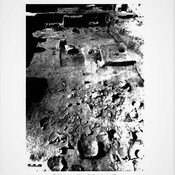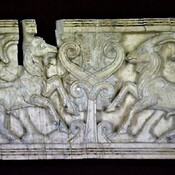Er zijn nog geen Nederlandstalige annotaties. Hier volgen annotaties in het Engels.
Melid was an ancient city on the Tohma River that has been identified with modern archaeological site Arslantepe near modern Malatya. Melid -Hittite: Malidiya or Midduwa; Akkadian: Meliddu: Urartian: Melitea and Latin: Melitene.
The settlement on the site dates back to the Neolithic period. During the Bronze Age, various sources refer to the city nemed as Maladiya, Melid, Milid or Meliddu. At this time, the city became the administrative center of a large region in the kingdom of Isuva. The Hittites managed to capture the city in the XIV century BC. After thecollapse of the Hittite empire, ( 12th to 7th century BC) the city became the center of an independent Luwian Neo-Hittite state of Kammanu. A palace and monumental stone sculptures depicting the ruler and lions were built this time A clash with the troops of the Assyrian king Tiglathpalassar I (1115-1077 BC) made the kingdom of Melid a tributary of Assyria. Sargon II (722–705 BC) sacked burned down the city in 712 BC. At the same time, the Cimmerians and Scythians invaded Anatolia, and the city has fallen into decay.
Hittite Malidiya town was an important Hittite town all the Hittite period.
See:
- Carlo Persiani: Changing settlement patterns in the Early Bronze 2 at Arslantepe (Malatya, Turkey), in: Restless Settlers ICAANE 4, vol. 1, Harrassowitz Ver. Wiesbaden 2008, pp.167-176
- Federico Manuelli, Arslantepe, Late Bronze Age: Hittite Influence and Local Traditions in an Eastern Anatolian Community, Arslantepe IX, Roma 2013
- Marcella Frangipane, Arslantepe-Malatya: A Prehistoric and Early Historic Center in Eastern Anatolia, The Oxford Handbook of Ancient Anatolia: (10,000-323 BCE) , 2011, pp. 968-992
- Corrado Alvaro: "Malatya-Melid: a new look on the 20th century's archaeological research. Some remarks on the topographical and architectural evidence," in Proceedings of the 6thInternational Congresson the Archaeologyof the Ancient Near EastMay, 5th-10th2009, “Sapienza” - Università di Roma Volume 3, 2010, pp. 273-278
- Maria Bianca D’Anna Between Inclusion and Exclusion :Feastingand RedistributionofMealsatLateChalcolithic Arslantepe(Malatya,Turkey), eTopoi. Journal for Ancient Studies, Special Volume 2 (2012)
Melid was an ancient city on the Tohma River that has been identified with modern archaeological site Arslantepe near modern Malatya. Melid -Hittite: Malidiya or Midduwa; Akkadian: Meliddu: Urartian: Melitea and Latin: Melitene.
The settlement on the site dates back to the Neolithic period. During the Bronze Age, various sources refer to the city nemed as Maladiya, Melid, Milid or Meliddu. At this time, the city became the administrative center of a large region in the kingdom of Isuva. The Hittites managed to capture the city in the XIV century BC. After thecollapse of the Hittite empire, ( 12th to 7th century BC) the city became the center of an independent Luwian Neo-Hittite state of Kammanu. A palace and monumental stone sculptures depicting the ruler and lions were built this time A clash with the troops of the Assyrian king Tiglathpalassar I (1115-1077 BC) made the kingdom of Melid a tributary of Assyria. Sargon II (722–705 BC) sacked burned down the city in 712 BC. At the same time, the Cimmerians and Scythians invaded Anatolia, and the city has fallen into decay.
Hittite Malidiya town was an important Hittite town all the Hittite period.
See:
- Carlo Persiani: Changing settlement patterns in the Early Bronze 2 at Arslantepe (Malatya, Turkey), in: Restless Settlers ICAANE 4, vol. 1, Harrassowitz Ver. Wiesbaden 2008, pp.167-176
- Federico Manuelli, Arslantepe, Late Bronze Age: Hittite Influence and Local Traditions in an Eastern Anatolian Community, Arslantepe IX, Roma 2013
- Marcella Frangipane, Arslantepe-Malatya: A Prehistoric and Early Historic Center in Eastern Anatolia, The Oxford Handbook of Ancient Anatolia: (10,000-323 BCE) , 2011, pp. 968-992
- Corrado Alvaro: "Malatya-Melid: a new look on the 20th century's archaeological research. Some remarks on the topographical and architectural evidence," in Proceedings of the 6thInternational Congresson the Archaeologyof the Ancient Near EastMay, 5th-10th2009, “Sapienza” - Università di Roma Volume 3, 2010, pp. 273-278
- Maria Bianca D’Anna Between Inclusion and Exclusion :Feastingand RedistributionofMealsatLateChalcolithic Arslantepe(Malatya,Turkey), eTopoi. Journal for Ancient Studies, Special Volume 2 (2012)


